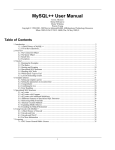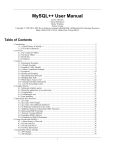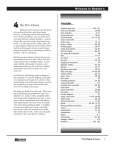Download User`s & Reference Guide
Transcript
Gemini
A minimization and error analysis
package in C++
Version 1.0
User’s & Reference Guide
August 1999
Zbigniew Szkutnik
Copyright CERN, Geneva 1997 - Copyright and any other appropriate legal protection of
this documentation and associated computer program reserved in all countries of the
world.
Organisations collaborating with CERN may receive this program and documentation
freely and without charge.
CERN undertakes no obligation for the maintenance of this program, nor responsibility
for its correctness, and accepts no liability whatsoever resulting from its use.
Program and documentation are provided solely for the use of the organisation to which
they are distributed.
This program may not be copied or otherwise distributed without permission. This
message must be retained on this and any other authorised copies.
The material cannot be sold. CERN should be given credit in all references.
This document has been prepared with Release 5.5 of the Adobe FrameMaker® Technical
Publishing System using the User’s Guide template prepared by Mario Ruggier of the
Information and Programming Techniques Group at CERN. Only widely available fonts
have been used, with the principal ones being:
Running text:
Chapter numbers and titles:
Section headings
Subsection and subsubsection headings:
Captions:
Listings:
Palatino 10.5 pt on 13.5 pt line spacing
AvantGarde DemiBold 36 and 24 pt
AvantGarde DemiBold 20 pt
Helvetica Bold 12 and 10 pt
Helvetica 9 pt
Courier Bold 9 pt
Use of any trademark in this document is not intended in any way to infringe on the
rights of the trademark holder.
Preface
Gemini is a GEneral MINImization and error analysis package implemented as a
C++ class library. Minuit’s functionality is provided in a ‘Minuit-style’ (even if,
internally, another minimizer may actually do the work) and new functionality
offered by NAG C minimizers is added. Gemini thus provides a unified C++ API
both to standard Minuit and to NAG C family of minimizers. For the common
subset of functionality, it is up to the user which minimization engine does the
work: Minuit or NAG C. The user can easily switch between various minimizers
without essential changes in the application code. The currently supported set of
minimizers (Minuit and NAG C) can be extended without essential changes in the
API.
The abstract base class GEmini defines an interface to the common functionality.
The CMinuit class is derived from GEmini and provides a Minuit-based
implementation of the GEmini functionality plus Minuit-specific extensions.
Similarly, the NAGmin class is derived from GEmini as well and provides a
NAG-based implementation of the GEmini functionality plus NAG-specific
extensions.
If the user’s minimization object is declared as being of type CMinuit, then Minuit
will be used as the minimization engine. Correspondingly, if the user declares the
object as being of type NAGmin, then NAG C minimizers will be used.
There is no single class which contains references both to Minuit and to NAG C.
This is done on purpose so that orthodox Minuit or NAG C users are not forced to
link the other library (only if the Gemini library is created as a static library).
Gemini finds a minimum of an objective function, possibly subject to general
constraints, and performs an error analysis. The concept of errors is that of Minuit,
so that it is the user’s responsibility to properly scale the inversed Hessian or,
equivalently, define the UP parameter, and to properly interpret the results. Both
Hessian based errors and Minos errors are implemented. Correspondingly, two
types of function contours (or confidence regions, in statistical problems) are
available: elliptical and Minos ones. Minos error analysis is, however, possible only
for unconstrained and bound constraint problems.
General constraints cover, in addition to the usual bound constraints, two
additional types of constraints:
Gemini - User’s & Reference Guide
3
Preface
- linear constraints of the form lb <= c’x <= ub, where c is a column vector of
coefficients, x is a column vector of objective function arguments, and lb and ub are
lower and upper bounds
- general non-linear constraints of the form lb <= h(x) <= up, where h() stands for
any function of the objective function arguments.
Problems with linear and/or non-linear constraints can only be solved be means of
the NAGmin class. Internally, the NAG minimizer nag_opt_nlp is used for such
problems. Although the objective function and the constraint functions are
assumed to be smooth (at least twice continuously differentiable), the method of
nag_opt_nlp will usually solve the problem, if there are only isolated
discontinuities away from the solution.
The only currently used minimizers are: MIGRAD for CMinuit and nag_opt_nlp for
NAGmin. Note, however, that the CMinuit-specific method command() allows for
execution of any Minuit command, thus providing an indirect way of using other
Minuit minimization methods, like SIMPLEX or MINIMIZE.
The objective function to be minimized is encapsulated in an OBJfun class. It can be
used simply to capture the usual user’s function (e.g. OBJfun f(chi2f);) or a user can
derive his own function class from it, add all the functionality needed in his/her
specific problem and override the virtual member function objfun with the actual
objective function.
Contours are implemented as an abstract data type GEminiContour with
overloaded assignment and addition operators. Its usage is described in detail in
section 1.6.
Gemini internally maintains two set of parameters: the initial setup used as a
starting point for the first minimization process and the result of the last
minimization. If another minimization process is started after the previous one is
completed and if no intermediate parameter redefinition has been done, then the
result of the previous minimization is used as the starting point for the next one.
Whenever a user (re)defines a parameter, both sets of parameters get updated. At
any stage of the analysis, the original starting point can be set by calling the
function resetStartPoint(). Thus, the same starting point can be re-used with another
minimizer but the results of the current minimization overwrite the previous ones.
The covariance matrix is computed but not stored in its final form. Only the
parameters’ errors are stored. In NAGmin, the covariance matrix is re-computed
from its Choleski factor and stored in a user’s matrix, if explicitly requested by a
call to getCovMatrix(), as described below. In CMinuit, the covariance matrix is
retrieved from the Minuit’s memory, if requested.
The application code must include gemini.h, the Gemini header file. NAG C header
files are not needed when the application code is being compiled.
Some examples are provided with the installation kit. At CERN, they can be
accessed at $LHCXXTOP/share/GEMINI/pro/examples.
Installation details are described in a HTML document accessible at CERN at
$LHCXXTOP/share/GEMINI/pro/doc/geminilib.html.
The package has been tested on HP (CC and aCC), IBM (xlC), DEC (cxx), Sun (CC),
Linux (egcs) and Windows NT (MS VC++5).
4
Gemini - User’s & Reference Guide
Preface
For details related to the minimization algorithms, the user is refered to the
corresponding manuals for Minuit [1] and NAG C [2].
Gemini - User’s & Reference Guide
5
Preface
6
Gemini - User’s & Reference Guide
Contents
Preface .
.
.
.
.
.
.
.
.
.
.
.
.
.
.
.
.
.
Chapter 1
Functions and objects . . . . . . . . . . . .
1.1 The objective function . . . . . . . . .
1.2 The objective function object . . . . . .
1.3 Minimization objects and their constructors
1.4 Generic pointer to a minimization object . .
1.5 General constraints functions . . . . . .
1.6 Contour objects . . . . . . . . . . .
Chapter 2
Common public methods .
2.1 Non-virtual methods
2.2 Virtual methods . .
2.3 Pure virtual methods
.
.
.
.
.
.
.
.
.
.
3
.
.
.
.
.
.
.
.
.
.
.
.
.
.
.
.
.
.
.
.
.
.
.
.
.
.
.
.
.
.
.
.
.
.
.
.
.
.
.
.
.
.
.
.
.
.
.
.
.
.
.
.
.
.
.
.
.
.
.
.
.
.
.
.
.
.
.
.
.
.
9
10
11
12
13
14
15
17
18
20
22
.
.
.
.
.
.
.
.
.
.
.
.
.
.
.
.
.
.
.
.
.
.
.
.
.
.
.
.
.
.
.
.
.
.
.
.
.
.
.
.
.
.
.
.
.
.
.
.
.
.
.
.
.
.
.
.
.
.
.
.
.
.
.
.
.
.
.
.
.
.
.
.
.
.
.
.
.
.
.
.
.
.
.
.
.
.
.
.
.
.
.
.
.
.
.
.
.
.
.
.
.
.
.
.
.
.
.
.
.
.
.
.
.
.
.
.
.
.
.
.
.
.
.
.
.
.
.
.
.
.
.
.
.
.
.
.
.
.
.
.
.
.
.
.
.
.
.
.
.
.
.
.
.
.
.
.
.
.
.
.
.
.
.
.
.
.
.
.
.
.
.
.
.
.
.
.
.
.
.
.
.
.
.
.
.
.
.
29
30
31
33
35
36
Chapter 3
Minimizer-specific extensions . .
3.1 Minuit-specific extensions
3.2 NAG-specific extensions .
Appendix A
Error analysis in Gemini . . . . . . . . . . .
3.3 General concept of errors . . . . . . .
3.4 Minos error analysis . . . . . . . . .
3.5 Hessian based error analysis . . . . . .
3.6 Practical summary . . . . . . . . . .
3.7 Error analysis in constrained minimization .
25
26
27
Bibliography
.
.
.
.
.
.
.
.
.
.
.
.
.
.
.
.
.
.
.
.
.
.
.
.
.
39
Index
.
.
.
.
.
.
.
.
.
.
.
.
.
.
.
.
.
.
.
.
.
.
.
.
.
41
.
.
.
Gemini - User’s & Reference Guide
7
Contents
8
Gemini - User’s & Reference Guide
Chapter 1
Functions and objects
This chapter describes the functions and objects used in Gemini.
1.1
The objective function . . . . . . . . . . . . . . . . . 10
1.2
The objective function object . . . . . . . . . . . . . . 11
1.3
Minimization objects and their constructors . . . . . 12
1.4
Generic pointer to a minimization object . . . . . . . 13
1.5
General constraints functions . . . . . . . . . . . . . 14
1.6
Contour objects . . . . . . . . . . . . . . . . . . . . . 15
Gemini - User’s & Reference Guide
9
Functions and objects
1.1
The objective function
The objective function is the function to be minimized. The user must supply a
C/C++ function which computes the objective function value and, optionally, its
gradient, for a given vector of function arguments. Computing as many gradient
components as possible will generally improve both performance and reliability.
The objective function has the prototype
void (int n, double g[], double *objf, const double x[], int code)
where:
n : Input: the number of function arguments
g[n] : Output: the function must not change the elements of g if no gradient is
computed. If the gradient is computed, its computed components should be filled
in g, if on input code=2.
objf : Output: the value of the objective function at the current point given in x.
x[n] : Input: the point x at which the function value (and possibly gradient) is
required.
code : Input: if code=0, only function value must be computed. If code=2, both the
function value and available gradient components should be computed. (For
Minuit, code=1 is allowed as well, in which case initialization tasks can be
performed. Note, however, that the initialization tasks can better be encapsulated
in the constructor of the user’s function class derived from OBJfun.)
A simple example function which implements a second-degree polynomial of one
variable may look as follows.
void fun(int n, double g[], double *f, const double x[], int code)
{ const double a = 1.0, b = 2.0, c = 1.0;
// compute function value
*f = a*x[0]*x[0] + b*x[0] + c;
if( code == 2 ) {
// compute gradient
g[0] = 2*a*x[0] + b;
}
}
The objective function may have any name, unless the user overrides the objfun
member of the objective function object, as described in the next section.
Although the objective function is assumed to be smooth (at least twice
continuously differentiable), the minimizers will usually solve the problem, if there
are only isolated discontinuites away from the solution.
10
Gemini - User’s & Reference Guide
The objective function object
1.2
The objective function object
The objective function object encapsulates the objective function, a function calls
counter and, possibly, some user-defined functionality, like initialization.
The objective function object OBJfun can simply capture a usual user function, say
chi2f(...),
OBJfun f(chi2f);
or the user can derive his/her own class from OBJfun with overriden virtual
member function objfun and, possibly, some problem-specific functionality added,
e.g.
class alephRb: public OBJfun {
public:
// user added functionality (initialization e.t.c.)
...
// override virtual objective function from OBJfun
void objfun(int n, double grad[], double *fval,
const double x[], int code);
private:
...
};
A function object can either be assigned to a minimization object via its constructor
or, alternatively, via a public method setObjFun(). At any time, only one OBJfun
object can be assigned to the fitting object. Any new assignment with setObjFun()
replaces the previous one. For CMinuit, any new function assignement forces
Minuit’s re-initialization, in order to avoid any interference with the previous
analysis. As a side-effect, the minimization options (like, e.g. the output level)
previously set get lost and have to be re-set.
Internally, a function calls counter is implemented. Two public methods give access
to this counter, although there is normally no need to do anything with the counter.
long counter(void)
Return the current value of the counter.
void resetCounter(void)
Reset the counter to zero.
Gemini - User’s & Reference Guide
11
Functions and objects
1.3
Minimization objects and their constructors
The minimization object is the main object which contains the complete problem
definition. It also provides methods for assigning an objective function object,
defining the objective function arguments and their admissible regions, setting
minimization options, running a minimizer, obtaining the current status of the
minimization process, obtaining results and error analysis.
If the minimization object is of type CMinuit, then Minuit is used as the
minimization engine. Similarly, if it is of type NAGmin, then NAG C minimizers
are used.
Current minimization object constructors are:
CMinuit()
CMinuit(int n, OBJfun *fptr)
CMinuit(const char *ptitle, int n, OBJfun *fptr)
and
NAGmin()
NAGmin(int n, OBJfun *fptr)
NAGmin(const char *ptitle, int n, OBJfun *fptr)
where:
n : number of arguments of the objective function
ptitle : optional problem title
fptr : pointer to the objective function object.
The length of the title is limited to 80 characters (as defined in gemini.h). If ptitle
points to a longer string, only the first 80 characters are stored as the problem’s title.
CMinuit() is equivalent to CMinuit(0, NULL) and NAGmin() is equivalent to
NAGmin(0, NULL). They create an empty minimization object. An objective
function object can then be assigned to such an empty fitting object by executing
setObjFun(), as described below.
At any time, only one OBJfun object can be assigned to the fitting object. Any new
assignment with setObjFun() replaces the previous one. For CMinuit, any new
function assignement forces Minuit’s re-initialization, in order to avoid any
interference with the previous analysis. As a side-effect, the minimization options
(like, e.g. the output level) previously set get lost and have to be re-set.
12
Gemini - User’s & Reference Guide
Generic pointer to a minimization object
1.4
Generic pointer to a minimization object
A generic pointer of the type (GEmini *) can point both to CMinuit and NAGmin
type objects and can be used if minimization objects are dynamically allocated on
the heap. This allows the user to select the minimizer at run time rather than at
compilation time. For example:
...
// capture the objective function
OBJfun f(myObjectiveFunction);
GEmini *mcptr;
int nop = 4; // number of function argument
if( something )
// use Minuit
mcptr = new CMinuit(“Minuit test“,nop,&f);
else
// use NAG C
mcptr = new NAGmin(“NAG C test“,nop,&f);
...
mcptr->minimize();
mcptr->printResults();
delete mcptr;
...
Gemini - User’s & Reference Guide
13
Functions and objects
1.5
General constraints functions
By default, the minimization problem is considered unconstrained, i.e. each
argument can take any real value. The user can, however, restrict the objective
function domain by imposing bound constraints (setting lower and/or upper
bounds for any argument), linear constraints (setting lower and/or upper bounds
for linear combinations of arguments) and general non-linear constraints (setting
lower and/or upper bounds for the values of arbitrary functions of the arguments).
In the latter case, for each non-linear constraint, the user must provide a C/C++
function which computes, for a given vector of arguments, the constraint function
value and, optionally, its gradient. Computing as many gradient components as
possible will generally improve both performance and reliability. The constraint
can then actually be imposed with setNlinConstraint().
A general constraint function has the prototype
void (int n, double g[], double* val, const double x[], int code)
where:
n : Input: the number of function arguments
g[n] : Output: the function must not change the elements of g if no gradient is
computed. If the gradient is computed, its computed components should be filled
in g, if on input code=2.
val : Output: the value of the constraint function at the current point given in x.
x[n] : Input: the point x at which the function value (and possibly gradient) is
required.
code : Input: if code=0, only function value must be computed. If code=2, both the
function value and available gradient components should be computed.
For example, if the objective function is a function of four arguments and if one
wants to impose a constraint on the sum of squares of the last two arguments, the
corresponding general constraint function might look as follows.
void cfun(int n, double g[], double *f, const double x[], int code)
{
// compute constraint function value
*f = x[2]*x[2] + x[3]*x[3];
if( code == 2 ) {
// compute gradient components
g[0] = g[1] = 0;
g[2] = 2*x[2];
g[3] = 2*x[3];
}
}
The constraint function can have any name. Although the constraint function is
assumed to be smooth (at least twice continuously differentiable), the minimizers
will usually solve the problem, if there are only isolated discontinuites away from
the solution.
A pointer to a constraint function is typedef(ined) as NLCF and is passed as
argument to the function setNlinConstraint().
14
Gemini - User’s & Reference Guide
Contour objects
1.6
Contour objects
A contour is a set of points from the boundary of a (bounded) set in a
two-dimensional subspace. In Gemini, it typically represents either an elliptical
boundary of a Hessian-based confidence region for a selected pair of parameters, or
a Minos contour, i.e. the curve on which the minimum of the objective function
with respect to all the remaining parameters equals the current minimum plus the
current value of the UP parameter, as set via the setError() function.
Contours are implemented in Gemini as a GEminiContour class. Along with the
contour points, stored in counter-clock order, GEminiContour also stores the
coordinates of the contour centre, the title assigned to the contour, and the point
marks, which are used for contour plotting in the text mode. Two public members
np and n contain, correspondingly, the number of data points to be filled and the
number of data points actually stored. Thus, np will typically be set before the
contour is filled, while n is set by the routine which actually fills the contour. The
default value of np is 20 and the default point mark is ‘*’.
The following contour constructors are available:
GEminiContour()
GEminiContour(int nop)
GEminiContour(char c)
GEminiContour(int nop, char c)
where:
nop : the required number of points
c : the point mark
A suitable copy constructor is provided, so that contours can safely be passed by
value.
The contour title is normally set by the contour filling routine. Once o contour is
filled, its title can be redefined by the user through the GEminiContour public
method
void setTitle(const char *str)
The title length is limited to 70. If str points to a longer string, it will be truncated.
Similarly, the contour centre is normally set by the contour filling routine to the
current minimum point, but can also be set explicitly through the public method
void setOrigin(double xo, double yo)
The contour can be plotted in the text mode for preliminary inspection through the
public method
void plot(void)
Gemini - User’s & Reference Guide
15
Functions and objects
The x- and y-coordinates of the points are stored in public arrays x and y and the
coordinates of the i-th contour points can be accessed as x[i] and y[i] with i=0,...,n-1.
The pointers to the double arrays of x’s and y’s are returned by public member
functions xp() and yp().
Whenever a declared contour is being filled, a public member n should be set to the
actual number of points filled. In Gemini it is done automatically and n is equal to
nop if the requested number of points has successfully been found.
Contours are implemented in Gemini as an abstract data type with overloaded
assignment and addition operators. Addition means, in this case, merging and can
be used for overlaying the contours. If the marks used in the two contours to be
added are non-conflicting, they will be preserved. Otherwise, new marks will be
created in such a way, that the points from the two added contours can still be
distinguished, when the sum is plotted. For example:
GEminiContour c1, c2;
...
// fill the contours
...
// plot overlayed contours
(c1+c2).plot()
The title and center are inherited by the sum from the left-most term.
16
Gemini - User’s & Reference Guide
Chapter 2
Common public methods
Gemini’s functionality is implemented in a set of non-virtual, virtual and pure
virtual methods in the abstract base class GEmini. Some virtual methods are
overriden in the derived classes CMinuit and NAGmin. Suitable versions are then
called according to the actual object type. All pure virtual functions are
implemented in the derived classes.
2.1
Non-virtual methods . . . . . . . . . . . . . . . . . . 18
2.2
Virtual methods . . . . . . . . . . . . . . . . . . . . . 20
2.3
Pure virtual methods . . . . . . . . . . . . . . . . . . 22
Gemini - User’s & Reference Guide
17
Common public methods
2.1
Non-virtual methods
int initParms(const char *file)
Read parameters setup from a text file. Return 0/1 in case od success/failure. Lines
starting with ‘/’ are ignored as comment lines. A line defining a parameter consists
of blank-separated tokens and must contain the parameter number and name.
Optionally, the initial value, lower bound, upper bound and step can be given.
Consequtive values are assigned to consequtive parameters in the given order.
Parameters, which are not explicitly defined, are treated as unbounded with initial
value zero.
void printSetup() const
Print the current problem setup to standard output, including title, minimization
method, initial parameters values, parameters bounds and steps.
int setLinConstraint(int cid, const double c[], double lb, double ub)
Add linear constraint with identifier cid, nop-vector of coefficients c, lower bound lb
and upper bound ub. Return 0/1 if success/failure. The function fails, if the
identifier is already in use. nop stands for the number of objective function
arguments. Pre-defined constants MINF (minus infinity) and INF (infinity) can be
used in case a bound is not imposed.
int setNlinConstraint(int cid, NLCF funptr, double lb, double ub)
Add non-linear constraint with identifier cid, constraint function pointer funptr,
lower bound lb and upper bound ub. Return 0/1 if success/failure. The function
fails, if the identifier is already in use. Pre-defined constants MINF (minus infinity)
and INF (infinity) can be used in case a bound is not imposed.
int removeConstraint(int cid)
Remove constraint number cid. Return 0/1 if success/failure. The function fails, if
there is no constraint with the identifier cid.
int getResult(int no, double& estimate, double& error, double& fval)
const
If called before minimization or after unsuccessful minimization, the function
returns 1. Otherwise 0 is returned and, for parameter number no, estimate is set to
the optimal parameter value, error to the error estimate and fval to the minimum
function value. If error was not successfully computed, error is set to -1.
18
Gemini - User’s & Reference Guide
Non-virtual methods
int getMinosErrors(int no, double& negative, double& positive) const
Retrieve Minos errors for parameter no. Zeros are returned in negative/positive if
the respective error has not been computed. The function fails if no is out of range
or minimization has not been performed yet. Return values: 0/1 = success/failure.
int ellipticalContour(int n, int m, GEminiContour& p) const
Find p.np points along a contour on the plane spanned by parameters n and m. The
contour is defined as the set of points in which the local parabolic approximation to
the objective function (based on the Hessian) takes the value min+UP, where min is
the current minimum, and UP is the value defined in setError(). Thus, it just
constructs standard confidence regions based on the marginal distributions of the
estimates. Note that elliptical contours can only be constructed after both a
minimum and the Hessian at the minimum have been found. Return values: 0/-1 =
success/failure.
void printResults() const
Print the results to standard output, including title, minimization method, number
of function calls, parameters, errors and function value at the minimum.
Gemini - User’s & Reference Guide
19
Common public methods
2.2
Virtual methods
virtual int parmDef(int no, const char *name, double value, double step,
double lBound, double uBound)
Define parameter number no by setting its name, value, step, lower bound lBound
and upper bound uBound and return 0/1 in case of success/failure. Pre-defined
constants MINF (minus infinity) and INF (infinity) can be used in case a bound is
not imposed. Setting value=lBound=uBound results in fixing the parameter at that
common value. Parameters, which are not explicitly defined, are treated as
unbounded with initial value zero. name can be set to NULL, in which case a
default name is assigned to the parameter.
virtual void setObjFun(int nofparms, OBJfun *fptr))
Assign a new objective function object pointed to by fptr and set the number of
parameters to nofparms. For NAGmin, the current parametrs’ definitions for
parameters 1 to nofparms and the current options setup are preserved. For
CMinuit, however, any new function assignement forces Minuit’s re-initialization,
in order to avoid any interference with the previous analysis. As a side-effect, the
previous parameters’ definitions and the minimization options previously set get
lost and have to be re-set.
virtual int resetStartPoint(void)
Reset start point to the original one. If a second call to minimize() is made without
any intermediate action, the current solution is taken as the starting point.
However, if this routine is called before the second minimize(), the original starting
point will be used rather than the current solution. Note that in any case the current
Hessian approximation gets forgotten , which may be useful if the Hessian is
extremely ill-conditioned (c.f. NAG C documentation [2]).
virtual void setTitle(const char *title)
Set problem title.
virtual void setError(double up)
Define the error parameter (same as Minuit’s UP value). The scale factor for the
inverted Hessian is then 2*up, thus leading to usual one-sigma-errors, if up=1 for
chi^2 or up=0.5 for negative log-likelihood. The default value for up is 1. It is the
user’s responsibility to correctly set this parameter and correctly interprete the
errors obtained. Negative values of up are ignored. Whenever setError() is called,
the parameters errors (if any) are recalculated and Minos errors get forgotten so
that the current stored solution is always consistent with the current value of the up
parameter.
20
Gemini - User’s & Reference Guide
Virtual methods
virtual int fixParm(int no)
Fix the parameter number no at the current value obtained in the minimization
process and return 0. If minimization has not been done yet, the function returns 1
with no change in the parameter setup.
virtual void warningsON(void)
Switch the warnings printout on (default).
virtual void warningsOFF(void)
Switch the warnings printout off.
virtual void setPrecision(double prec)
Precision corresponds to the Minuit’s parameter EPS or Nag options.f_prec. It
defines the precision to which the objective function can be computed. See
corresponding manuals for details.
virtual void setTolerance(double tol)
Tolerance is Nag options.optim_tol and corresponds to Minuit’s tolerance parameter.
The algorithm stops if the estimated vertical distance to the minimum is smaller
than tol. (NOTE: The last statement is precisely true for MIGRAD, but only
approximately true for nag_opt_nlp where the convergence criteria are slightly more
complicated. See [2] for more details.)
Gemini - User’s & Reference Guide
21
Common public methods
2.3
Pure virtual methods
virtual void setPrintLevel(int level)
Set printout level (level= -1,0,1,2,3).
virtual int minimize(void)
Solve the current minimization problem by means of the currently selected method.
Return 0/1 in case of success/failure.
virtual int getCovMatrix(int n, double cov[]) const
Let nofp stand for the number of currently free parameters. If n <= nofp, the function
fills the n*n cov matrix with the n by n portion of the covariance matrix. If n > nofp,
the upper left corner of the cov matrix is filled with nofp*nofp elements of the
covariance matrix and the remaining elements of cov are not modified. Thus,
following Minuit’s tradition, we drop here the rows and columns of zeros, which
correspond to parameters which are either fixed or on the boundary. The function
returns 0/1 in case of success/failure. cov is a n*n array stored row-wise. Note that
the returned matrix is the genuine covariance matrix only if the error parameter up
has been set correctly, i.e. such that the usual one-sigma-errors are computed (c.f.
the description of setError() above).
virtual int getCov(int n, int m, double& cov) const
Set cov to the covariance of the parameters n and m. Return 0/1 in case of
success/failure. In the NAGmin implementation, the covariance matrix is
re-calculated from its Choleski factor whenever this function is called. Thus, if
many covariances are to be obtained, it will be much more efficient to call
getCovMatrix() and pick up suitable elements rather than to call getCov() many
times. As above, cov is the genuine covariance only if the error parameter up has
been set correctly, i.e. such that the usual one-sigma-errors are computed.
virtual int minosErrors(int n, double& neg, double& pos)
Find Minos errors for parameter n, store internally and return them in neg and pos.
Return values: 0=success, 1=errors out of limits, 2=new minimum found, 3=no of
function calls exceded its limit, 4=other failure.
virtual int minosContour(int n, int m, GEminiContour& p)
Try to find p.np points along a contour on the plane spanned by parameters n and
m. The contour is defined as the set of points in which the minimum of the objective
function w.r.t. all the remaining parameters equals min+UP, where min is the
22
Gemini - User’s & Reference Guide
Pure virtual methods
current minimum, and UP is the value defined in setError(). p.n is set to the number
of points actually found. Return values: number of points found if successful,
0=less than 4 points found, -1=other failure
Gemini - User’s & Reference Guide
23
Common public methods
24
Gemini - User’s & Reference Guide
Chapter 3
Minimizer-specific extensions
Some useful minimizer-specific features are implemented as extensions, so that
they are not part of the GEmini class.
3.1
Minuit-specific extensions . . . . . . . . . . . . . . . 26
3.2
NAG-specific extensions . . . . . . . . . . . . . . . . 27
Gemini - User’s & Reference Guide
25
Minimizer-specific extensions
3.1
Minuit-specific extensions
int command(const char *cmd, const double args[], int argsno) const
Execute Minuit command cmd with argsno arguments given in the array args.
Return 0/1 in case of success/failure. This corresponds to the Minuit’s subroutine
MNEXCM.
void commandMode(void) const
Switch to the command mode with commands read from standard input. This is an
analog of the Minuit’s subroutine MNINTR.
26
Gemini - User’s & Reference Guide
NAG-specific extensions
3.2
NAG-specific extensions
Optional parameters can be set via a file e04ucc.opt. The file is read and options are
initialized when an object of the type NAGmin is created. One very useful option
which can be set via e04ucc.opt is verify_grad, which has the effect that the minimizer
verifies user-provided gradient components. This is very useful while debugging a
newly written application. See section E04 in the NAG C library manual [2] for
more details.
If the user objective function computes ALL the gradient elements, then setting
options.obj_deriv to TRUE will improve both performance and reliability.
NAGmin solves problems with general constraints and performs the related error
analysis. Note that Minuit is not able to solve such problems, even if general
constraints can be set in the CMinuit class (minimize() will fail in that case).
Gemini - User’s & Reference Guide
27
Minimizer-specific extensions
28
Gemini - User’s & Reference Guide
Appendix A
Error analysis in Gemini
3.3
General concept of errors. . . . . . . . . . . . . . . . 30
3.4
Minos error analysis . . . . . . . . . . . . . . . . . . 31
3.5
Hessian based error analysis . . . . . . . . . . . . . . 33
3.6
Practical summary . . . . . . . . . . . . . . . . . . . 35
3.7
Error analysis in constrained minimization . . . . . 36
Gemini - User’s & Reference Guide
29
Error analysis in Gemini
3.3
General concept of errors
The general concept of ’errors’ or ’uncertainties’ in Gemini is the same as in Minuit.
For a given objective function F ( θ ) to be minimized, with θ = ( θ 1, …, θ p ) , and for a
given error parameter UP, the ’uncertainty set’ US of the solution θ̃ = ( θ̃ 1, …, θ̃ p ) is
defined as
(1)
US = { θ : F ( θ ) – F ( θ̃ ) ≤ UP }
For any sub-vector of θ̃ , the uncertainty set is constructed as the orthogonal
projection of US onto the corresponding plane spanned by the selected
components.
This purely geometrical concept is meaningful, in qualitative sense, for arbitrary
objective functions. ’Errors’ or ’uncertainties’ are related to the shape of the
objective function in a neighbourhood of the minimum.
Well defined quantitative meaning, in probabilistic terms, can be assigned to such
defined ’errors’ or ’uncertainties’ in statistical problems, when the objective
function is a fit criterion, for example a chi-squared, log-likelihood or least squares
loss function.
Error analysis based on the plain difference F ( θ ) – F ( θ̃ ) is called Minos analysis, as
in Minuit. In this context, we also use terms like Minos error and Minos confidence
region. Minos analysis can be computationally very costly, however, as it requires
multiple function minimization to find points on the boundary of US or of its
projection. It will be seen below, how Minos analysis can formally be justified in
statistical terms. For maximum likelihood estimators and standard minimum
chi-squared estimators, for example, it can be done via the asymptotic chi-squared
distribution of a suitably transformed likelihood ratio.
A standard way to overcome the computational difficulty of Minos analysis is to
T
approximate F ( θ ) – F ( θ̃ ) with 0.5 ⋅ ( θ – θ̃ ) H ( θ – θ̃ ) , with H being the Hessian of F at
θ̃ . One obtains this approximation via the standard Taylor expansion of F around θ̃
and using the fact that the gradient of F at the minimum is zero. With this
approximation, approximate versions of both US and its projections can be found
analytically, so that multiple function minimization can be avoided. This leads to
the standard Hessian-based error analysis and is related to asymptotically normal
distributions of estimators.
In the following sections, those two approaches are described in more detail and
their links to standard statistics exposed. Unconstrained minimization problems
are discussed first. Error analysis for problems with constraints is the subject of the
last section. It is always assumed that the problem is regular enough for the
underlying mathematical theory to be applicable. The aim of this description is to
expose main ideas rather than to present technical details. Relevant mathematical
results can be found, for example, in the books by Silvey [4], Bard [5] and Serfling
[3]. The book by Eadie at al. [6] is a standard statistical reference for HEP-physicists.
It contains, in particular, a discussion of the Minos idea in less formal terms of an
’implicit transformation to linearity and back’, which provides further insight into
the idea of Minos.
30
Gemini - User’s & Reference Guide
Minos error analysis
3.4
Minos error analysis
The Minos uncertainty set US for the whole vector θ is defined above in (1). In
order to obtain an uncertainty set for two components only, say θ 1 and θ 2 , we have
to project US onto the plane spanned by those components. This projection is a set
of points (θ 1,θ 2) such that, for some θ 3 ,… ,θ p , F(θ ) ≤ F ( θ̃ ) + UP . Equivalently, it is the
set of points (θ 1,θ 2) such that the minimum of F ( θ ) with respect to θ 3 ,… ,θ p and with
θ 1 and θ 2 fixed is not greater than F ( θ̃ ) + UP . The boundary of this set is thus the
contour of the function
F̃ ( θ 1, θ 2 ) = min θ , …, θ F ( θ )
3
p
which corresponds to F̃ ( θ 1, θ 2 ) = F ( θ̃ ) + UP .
For a single parameter, say θ 1 , we define a function
F̂ ( θ 1 ) = min θ2, …, θ p F ( θ )
and construct the uncertainty set, or the projection of US, as { θ 1 : F̂ ( θ 1 ) ≤ F ( θ̃ ) + UP } .
For a regular function F, genuine local minimum θ̃ and ’small’ UP, this will be an
interval [θ 1,θ 1] , say. The positive and negative Minos errors are then defined as,
correspondingly, θ 1 – θ̃ 1 and θ̃ 1 – θ 1 .
In order to give Minos errors a quantitative, statistical meaning, let us assume first
that F is -2*log-likelihood for a regular statistical model. The unrestricted minimum
θ̃ of F is then a maximum likelihood estimator of θ . Let further θ̂ be the minimum
of F, subject to r independent restrictions h 1 ( θ ) = h 2 ( θ ) = … = h r ( θ ) = 0 . It is well
known that, for any true θ which satisfies the restrictions, F ( θ̂ ) – F ( θ̃ ) is
asymptotically chi-squared distributed with r degrees of freedom - a fact used for
the construction of the so-called asymptotic likelihood ratio test ( λ -test).
It follows immediately that, for any true θ with the given values of the first two
components, F̃ ( θ 1, θ 2 ) – F ( θ̃ ) is asymptotically chi-squared distributed with two
degrees of freedom (we impose two constraints by fixing the values of θ 1 and θ 2 )
and, for any true θ with the given value of the first component, F̂ ( θ 1 ) – F ( θ̃ ) is
asymptotically chi-squared distributed with one degree of freedom (we fix the
value of θ 1 only).
A standard Neyman asymptotic ( 1 – α ) -confidence region for (θ 1,θ 2) can then be
constructed as
{ (θ 1,θ 2) : F̃ ( θ 1, θ 2 ) – F ( θ̃ ) ≤ c α }
with c α being the ( 1 – α ) -quantile of the chi-squared distribution with two degrees
of freedom. This is exactly the projection of US, with UP = c α , onto the plane
spanned by the first two components.
Similarly, an asymptotic Neyman ( 1 – α ) -confidence region for θ 1 is
{ θ 1 : F̂ ( θ 1 ) – F ( θ̃ ) ≤ c α }
with c α being the ( 1 – α ) -quantile of the chi-squared distribution with one degree of
freedom. Again, this is the projection of US with UP = c α onto the first axis.
With obvious modifications, the same argument applies, of course, to any subset of
the components of θ .
Gemini - User’s & Reference Guide
31
Error analysis in Gemini
To summarize:
If F is -2*log-likelihood, then Minos confidence regions for r
components of θ have the asymptotic coverage probability 1 – α , if
UP is the ( 1 – α ) -quantile of the chi-squared distribution with r
degrees of freedom.
The scale factor of F is essential. Additive terms which do not depend on θ can be
dropped, however.
With r = 1 and UP = 1, the coverage probability corresponds to that of a
’ ± one-sigma error bar’ for a single parameter.
In Gaussian models, -2*log-likelihood equals, up to a constant, additive term, the
chi-squared fit criterion and the whole analysis applies. In many other cases, the
equality holds asymptotically, thus validating the Minos analysis with F being the
chi-squared fit criterion. For example, using the Taylor expansion of log’s around
n i , the -2*log-likelihood for the standard Poisson model for histogram cells counts
can be written as
– 2 ⋅ log L = – 2 ∑ [ n i log f i ( θ ) – f i ( θ ) – log n i! ] =
i
–2 ∑
i
2
f i ( θ ) – ni ( f i ( θ ) – ni )
– ------------------------------- – f i ( θ ) – log n i! =
n i log n i + ----------------------2
ni
2ζ i
2
( f i ( θ ) – n i ) n i 2
- ⋅ ---- + C
∑ ----------------------------- ξ i
ni
i
where C does not depend on θ and each ζ i lies between n i and f i ( θ ) . Strong law of
large numbers implies that n i / f i ( θ ) tends to 1 with probability one, as the sample
size increases ( f i ( θ ) also increases, in this case!). We thus have
2
( f i ( θ ) – ni )
( – 2 ) ⋅ log L = C + ( 1 + o ( 1 ) ) ∑ ------------------------------ni
i
which shows that, indeed, the chi-squared criterion is asymtotically equivalent to
-2*log-likelihood and that Minos analysis is asymptotically valid for the Poisson
histogram cells counts model.
32
Gemini - User’s & Reference Guide
Hessian based error analysis
3.5
Hessian based error analysis
In the Hessian-based error analysis, F ( θ ) – F ( θ̃ ) is approximated with
T
0.5 ⋅ ( θ – θ̃ ) H ( θ – θ̃ ) , with H being the Hessian of F at θ̃ . The approximate version
US’ of the uncertainty set US, corresponding to a given value of the UP parameter
takes then the form
T
1
US' = θ : --- ( θ – θ̃ ) H ( θ – θ̃ ) ≤ UP
2
(2)
The orthogonal projection US' r of US' onto the plane spanned by, say, the first r
components of θ consists of all points ( θ 1, …, θ r ) such that the minimum of
T
( θ – θ̃ ) H ( θ – θ̃ ) with respect to θ r + 1, …, θ p is not greater than 2*UP. Let us split θ – θ̃
into two sub-vectors: θ I consisting of the first r components and θ II consisting of
the remaining p-r components. Correspondingly, we can write
H =
H 1 H 12
T
H 12 H 2
with H 1 of size (r,r) and H 2 of size (p-r,p-r). Looking for a minimum with respect to
θ II and with θ I fixed, we have then
T
T
T
T
( θ – θ̃ ) H ( θ – θ̃ ) = θ I H 1 θ I + 2θ I H 12 θ II + θ II H 2 θ II = G ( θ II )
and
T
grad G ( θ II ) = 2H 12 θ I + 2H 2 θ II
The equation grad G ( θ̃ II ) = 0 gives the minimum point θ̃ II = – H –21 H T12 θ I . The
minimum value is
T
–1
T
G ( θ̃ II ) = θ I ( H 1 – H 12 H 2 H 12 )θ I
which gives
1 T
–1 T
US' r = θ I : --- θ I ( H 1 – H 12 H 2 H 12 )θ I ≤ UP
2
On the other hand, using the symmetric, block matrix inversion formula, we have
(3)
H 1 H 12
T
H 12
–1
–1
=
T
( H 1 – H 12 H 2 H 12 )
H2
X
T
–1
X
–1
H2 (I
T
– H 12 X )
–1
with X T = – H –21 H T12 ( H 1 – H 12 H –21 H T12 ) . This means that, with S = ( 0.5H ) –1 , we can
write
T –1
US' = { θ : ( θ – θ̃ ) S ( θ – θ̃ ) ≤ UP }
and, denoting by S r the upper left (r,r) portion of S, the projection US' r takes the
form
(4)
T –1
US' r = { θ I : θ I S r θ I ≤ UP }
Gemini - User’s & Reference Guide
33
Error analysis in Gemini
In order to set this in relation with statistics, recall that if F is -2*log-likelihood, then
the maximum likelihood estimator θ̃ is, in regular cases, asymptotically normally
distributed
–1
θ̃ ∼ AN ( θ, I θ )
where I θ = 1 ⁄ 2 ⋅ E θ H is the Fisher information matrix for the whole data set. Again,
in regular cases, one can reasonably assume that E θ H ≈ H ( θ̃ ) and use the inverse of
1 ⁄ 2 ⋅ H ( θ̃ ) as an estimate S of the covariance matrix of θ̃ .
T
This is clearly related to (2) and means that, since ( θ – θ̃ ) S –1 ( θ – θ̃ ) is asymptotically
chi-squared distributed with p degrees of freedom, in order to have the asymptotic
1 – α coverage probability for US’, one should set UP to the ( 1 – α ) -quantile of the
chi-squared distribution with p degrees of freedom.
Further, S r in (4) can clearly be interpreted as the covariance matrix of the marginal
distribution of ( θ 1, …, θ r ) and, in view of its asymptotic normality, setting UP in (4)
to the ( 1 – α ) -quantile of the chi-squared distribution with r degrees of freedom, we
get the asymptotic coverage probability 1 – α for US' r .
More generally, the above argument can be extended to any M-estimator, in which
case the asymptotic covariance matrix needs not to be the inverse of the Fisher
information matrix, but continues to be the (properly normalized) inversed
Hessian.
For the chi-squared fit criterion, the approximation argument from the previous
section applies.
34
Gemini - User’s & Reference Guide
Practical summary
3.6
Practical summary
The covariance matrix in Gemini is computed for unrestricted minimization
problems as S = 2 ⋅ UP ⋅ H –1 and the Hessian-based error of θ̃ i is calculated as s ii .
The following table summarizes the rules for proper setting of UP for single
parameter’s errors
-log L
-2 log L
chi-squared
one-sigma-error
UP = 0.5
UP = 1
UP = 1
two-sigma-error
UP = 2
UP = 4
UP = 4
three-sigma-error
UP = 4.5
UP = 9
UP = 9
For a standard least squares fit, the values of UP should be taken from the last row
2
and multiplied by the standard estimate σ̂ of the residual variance. Since the
variance estimate can only be computed after the fit, the value of UP can be set
before minimization as for a chi-squared fit and the computed errors multiplied by
σ̂ afterwards.
For simultaneous 1 – α confidence regions for r parameters, UP should be set to the
( 1 – α ) -quantile of the chi-squared distribution with r degrees of freedom for -2log L
or chi-squared fit criteria and to half of that value for -log L. For a least squares fit,
the values of UP should be computed as for the chi-squared fit and multiplied by
2
the standard estimate σ̂ of the residual variance.
Gemini - User’s & Reference Guide
35
Error analysis in Gemini
3.7
Error analysis in constrained minimization
A special case of constraints are bound constraints. Both Minos and Hessian-based
error analysis apply to problems with bound constraints. If a bound constraint is
active, i.e. a variable is on its boundary, it is considered fixed at that value and,
correspondingly, its ’error’ is set to zero. For non-active constraints, Minos
confidence regions are forced to be contained in the admissible regions and are
cropped, if necessary. Hessian-based error analysis is not affected by non-active
bound constraints.
For general constraints, the situation is different. Even if Minos analysis is
potentially applicable to problems with general constraints, it is likely that the
uncertainty sets are rather irregular or even degenerate, due to the restrictions
imposed. In effect, it is rather difficult to construct a general algorithm able to
handle those, rather arbitrary, sets. The Minos algorithm has been imported to
Gemini from Minuit with only minor modifications. It has been designed and
works effectively, however, only if the uncertainty sets are rather regular, especially
if they are convex and non-degenerate, as it is typically the case in fitting
applications with no general constraints imposed. Although it seems feasible to use
the Minos algorithm for single-parameter’s errors in general constrained problems,
it has not been sufficiently tested yet and remains to be done. In Gemini, only
Hessian-based error analysis, as described below, has been implemented for
problems with general constraints.
The standard approach to constrained minimization is via the Lagrange functional.
Only active constraints influence the error analysis. Assume that F=-log-likelihood.
Let h ( θ ) = [ h 1 ( θ ), …, h k ( θ ) ] T denote the vector of constraints active at the solution
and λ = [ λ 1, …, λ k ] T be the vector of Lagrange coefficients. The solution θ̃ is then
obtained by setting to zero the gradient of the Lagrangian
T
G ( θ, λ ) = F ( θ ) – λ h ( θ )
and solving the equation with respect to θ and λ .
Denote by A θ the (p,k) matrix of gradients of h ( θ ) and write
I θ Aθ
T
Aθ
–1
=
Vθ Q
T
Q Vλ
0
where I θ is the Fisher information matrix for the whole data set. It can be shown
that, in regular models,
θ̃ ∼ AN (θ, V θ)
and
λ̃ ∼ AN (0, – V λ)
and θ̃ and λ̃ are asymptotically independent. More explicitly, one can show that
(5)
–1
–1
T –1
T –1
–1
λ̃ ∼ AN (0, ( A θ I θ A θ ) )
36
Gemini - User’s & Reference Guide
–1 T –1
θ̃ ∼ AN (θ, I θ – I θ A θ ( A θ I θ A θ ) A θ I θ )
Error analysis in constrained minimization
Recall that I θ equals the expectation of the Hessian of F=-log-likelihood and that it
is usually approximated by the Hessian at the minimum. In the process of a
constrained minimization, however, the Hessian of the Lagrangian at the minimum
is easily obtainable and not that of F. Those two Hessians differ by terms of the
form
∑ λi ⋅
i
2
∂
h (θ)
∂ θ j ∂θ l i
which, according to (5), may increase at the rate of the square-root of the sample
size. Since the Hessian of F increases at the rate of the sample size, the difference
between inverses of those two Hessians becomes asymptotically insignificant. As a
result, with H denoting the Hessian of the Lagrangian at θ̃ , one can approximate
the covariance matrix of θ̃ as follows
(6)
Vθ ≅ H
–1
–H
–1
T
Aθ ( Aθ H
–1
–1 T
Aθ ) Aθ H
–1
As a by-product of the minimization process, the NAG C minimizer nag_opt_nlp,
used in Gemini to solve constrained problems, provides the upper triangular
Choleski factor R such that H = R T R . A convenient way of computing V θ is then to
solve the equation R T B = A θ with respect to B and compute
–1
T
–1 T
–1 T
V θ = R ( I – B( B B) B )( R )
or, alternatively, to find the QR decomposition B = QU of B, form a matrix Q1
consisting of the last p-k columns of Q, and compute
–1
–1
V θ = ( R Q1 ) ( R Q1 )
T
The latter method is used in Gemini.
It is instructive to see how this formalism works for simple bound constraints. In
this case, we can permute the parameters so that the last k of them are effectively
fixed and
0
I
Aθ =
Let us write
T
H = P Q
Q D
and
H
–1
T
=
P* Q*
Q* D*
with D and D * of size (k,k). Obviously
T
( Aθ H
–1
Aθ )
–1
–1
= D*
and, using (6), one obtains after some elementary algebra
T
–1
V θ = P* – Q* D* Q* 0
0
0
The block matrix inversion formula (3) applied to ( H –1 )
–1
then immediately gives
–1
Vθ = P 0
0 0
Gemini - User’s & Reference Guide
37
Error analysis in Gemini
which means that the covariance matrix of the free parameters can be obtained by
removing those rows and columns of the Hessian which correspond to the fixed
parameters and inverting the resulting sub-Hessian.
38
Gemini - User’s & Reference Guide
Bibliography
1
Minuit. Function Minimization and Error Analysis. Reference Manual.
F.James; CERN Program Library Long Writeup D506, 1994.
2
NAG C Library Manual, Mark 5, Vol. 2.
The Numerical Algorithms Group Limited, 1998.
3
Approximation Theorems of Mathematical Statistics.
R.J.Serfling; Wiley, 1980.
4
Statistical Inference.
S.D.Silvey; Chapman and Hall, 1975.
5
Nonlinear Parameter Estimation.
Y.Bard;Academic Press, 1974.
6
Statistical Methods in Experimental Physics.
W.T.Eadie, D.Drijard, F.James, M.Roos and B.Sadoulet; North-Holland, 1971.
Gemini - User’s & Reference Guide
39
Bibliography
40
Gemini - User’s & Reference Guide
Index
C
CMinuit, 3, 12, 13, 17, 27
CMinuit.command(), 26
CMinuit.commandMode(), 26
constraint identifier, 18
contour, 4, 15, 19, 22
covariance matrix, 4, 22
E
ellipticalContour(), 19
F
fixParm(), 21
function calls counter, 11
G
GEmini, 3, 17
GEminiContour, 4, 15
GEminiContour.plot(), 15
GEminiContour.setOrigin(), 15
GEminiContour.setTitle(), 15
general constraint function, 14
general constraints, 4, 18, 27
generic pointer, 13
getCov(), 22
getCovMatrix(), 4, 22
getMinosErrors(), 19
getResult(), 18
gradient, 10, 14, 27
H
Hessian, 3, 15, 19, 20
I
include files, 4
INF, 18, 20
Gemini - User’s & Reference Guide
41
Index
initParms(), 18
L
linear constraints, 4, 18, 27
M
MIGRAD, 4
MINF, 18, 20
minimization object, 12
minimize(), 20, 22
Minos, 3, 15, 19, 20, 22
minosContour(), 22
minosErrors(), 22
Minuit, 26
MNEXCM, 26
MNINTR, 26
N
nag_opt_nlp, 4
NAGmin, 3, 12, 13, 17, 27
NLCF, 14
O
objective function, 4, 10
objective function object, 11, 12
OBJfun, 4
OBJfun.counter(), 11
OBJfun.resetCounter(), 11
overlaying contours, 16
P
parmDef(), 20
printResults(), 19
printSetup(), 18
problem title, 12
R
removeConstraint(), 18
resetStartPoint(), 20
S
selection of minimizer, 12, 13
setError(), 15, 20, 22
setLinConstraint(), 18
setNlinConstraint(), 14, 18
setObjFun(), 20
setPrecision(), 21
setPrintLevel(), 22
setTitle(), 20
setTolerance(), 21
42
Gemini - User’s & Reference Guide
Index
U
UP value, 20
W
warningsOFF(), 21
warningsON(), 21
Gemini - User’s & Reference Guide
43
Index
44
Gemini - User’s & Reference Guide






















































![[U2.08.07] Distribution de calculs paramétriques](http://vs1.manualzilla.com/store/data/006355796_1-b6496958601556e7ee391401bb295054-150x150.png)